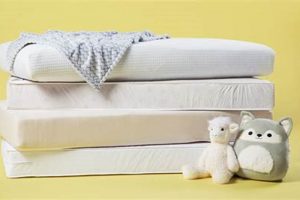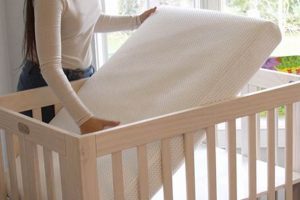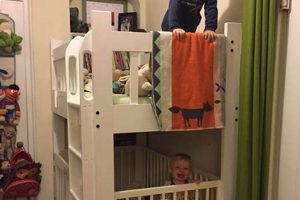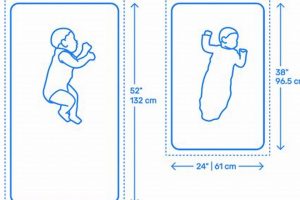This specialized infant bedding is designed with two distinct firmness levels. One side typically offers a firmer surface, intended for newborns and younger infants to promote safer sleep and reduce the risk of suffocation. The opposite side features a slightly softer surface, suitable for toddlers as they develop and require a more comfortable sleep environment.
Its primary advantage lies in its adaptability, potentially saving parents the expense of purchasing separate mattresses as their child grows. Furthermore, it addresses differing support requirements at various developmental stages, aligning with pediatric recommendations for safe sleep practices. The concept arose from an increasing awareness of infant sleep safety and the desire to provide optimal comfort for older babies.
The following sections will delve into the specific features, safety standards, and material considerations relevant to this type of bedding, providing a detailed overview for informed decision-making.
Selecting a Dual-Sided Crib Mattress
The following recommendations are designed to assist in the selection process of a dual-firmness crib mattress, emphasizing safety and longevity.
Tip 1: Prioritize Safety Certifications: Verify the product’s compliance with safety standards established by organizations such as the Consumer Product Safety Commission (CPSC) and ASTM International. These certifications indicate rigorous testing for harmful chemicals and structural integrity.
Tip 2: Assess Firmness Appropriately: The infant side should exhibit minimal give under pressure. This firmness is crucial for preventing indentation and reducing the risk of positional asphyxia in newborns. Test by applying firm pressure; the surface should remain stable.
Tip 3: Evaluate Material Composition: Opt for materials that are hypoallergenic, breathable, and free from phthalates, lead, and other potentially harmful substances. Consider options like organic cotton or CertiPUR-US certified foam for enhanced safety.
Tip 4: Examine Edge Support: Sturdy edge support prevents sagging and minimizes the risk of infants becoming trapped between the mattress and crib rails as they begin to move more actively.
Tip 5: Consider Waterproofing: A waterproof or water-resistant cover facilitates cleaning and prevents moisture from penetrating the core, inhibiting the growth of mold and bacteria. Ensure the cover is easily removable and washable.
Tip 6: Measure Crib Compatibility: Confirm the mattress dimensions precisely match the interior dimensions of the crib. Gaps exceeding two finger widths between the mattress and crib frame pose a safety hazard.
By adhering to these guidelines, parents can make an informed decision, prioritizing their child’s safety and well-being when selecting a dual-firmness crib mattress.
The subsequent section will address the longevity and proper maintenance of this type of mattress, ensuring optimal performance throughout its lifespan.
1. Infant Firmness
Infant firmness is a critical design element of a dual-firmness crib mattress, directly impacting infant safety. The firmer side of the mattress is specifically engineered to provide a stable, unyielding surface for newborns and young infants. This firmness is crucial because it reduces the risk of Sudden Infant Death Syndrome (SIDS) and positional asphyxia. A soft surface can conform to the infant’s face, potentially obstructing airways. A firmer surface prevents this, allowing the infant to breathe freely even if they roll onto their stomach. Regulatory bodies and pediatricians consistently recommend firm mattresses for infants, making it a non-negotiable feature in the design and marketing of these mattresses.
The practical significance of infant firmness extends to the selection process. Parents must actively verify the firmness of the designated infant side, often through tactile testing or by reviewing product specifications outlining compliance with relevant safety standards. For example, mattresses meeting ASTM standards have undergone rigorous testing to ensure adequate firmness. Furthermore, the firmness level influences material selection; denser foam or tightly coiled innersprings are typically used to achieve the necessary level of support.
In summary, infant firmness is not merely a feature but a core safety component of dual-firmness crib mattresses. Its role in mitigating suffocation risk is paramount, driving design choices, material selection, and regulatory compliance. Comprehending this connection is essential for parents aiming to create a safe sleep environment for their infants. While toddler side comfort is a consideration, the initial, unwavering firmness of the infant side remains the primary safety focus.
2. Toddler Comfort
The comfort level offered by the toddler side of a dual-firmness crib mattress is a vital consideration as infants transition into toddlerhood. This aspect acknowledges the evolving physical and developmental needs of a growing child, shifting the focus from rigid safety requirements to a balance between support and cushioning.
- Spinal Alignment
As toddlers develop more defined spinal curves, a slightly softer surface can promote healthier spinal alignment during sleep. Unlike newborns who require a flat, unyielding surface, toddlers benefit from a mattress that contours gently to their body, reducing pressure points and promoting comfortable rest. An overly firm mattress can lead to discomfort and restlessness, potentially disrupting sleep patterns.
- Pressure Point Relief
Toddlers engage in increased physical activity, leading to potential muscle soreness and joint stress. A moderately soft surface can distribute weight more evenly, alleviating pressure on hips, shoulders, and other key joints. This feature contributes to a more restful sleep, allowing the body to recover and repair itself overnight. Mattresses incorporating memory foam or conforming latex layers often address this need effectively.
- Temperature Regulation
Toddlers, like infants, are susceptible to overheating. Breathable mattress materials are crucial for regulating body temperature and preventing discomfort due to excessive sweating. Open-cell foam structures and natural fibers like cotton or bamboo allow for better air circulation, wicking away moisture and promoting a cooler sleep environment. Overheating can disrupt sleep and increase the risk of skin irritation.
- Material Sensitivity
Toddlers may develop sensitivities or allergies to certain materials. Hypoallergenic mattress options, constructed from natural latex or organic cotton, minimize the risk of allergic reactions and skin irritations. Choosing materials free from harsh chemicals and flame retardants further reduces potential exposure to irritants, promoting a healthier sleep environment. The prevalence of eczema and other skin conditions in toddlers underscores the importance of selecting hypoallergenic bedding.
Ultimately, the toddler comfort aspect of a dual-firmness crib mattress acknowledges the developmental progression of a child’s needs. While safety remains paramount throughout the crib years, the inclusion of a slightly softer, more conforming surface caters to the increased comfort requirements of a growing toddler, promoting restful sleep and supporting healthy physical development.
3. Safety Standards
Adherence to stringent safety standards is paramount in the design and manufacture of dual-firmness crib mattresses. These standards are established to mitigate potential hazards associated with infant sleep environments, ensuring the well-being of the child. The multi-faceted nature of these regulations addresses various aspects, from material composition to structural integrity.
- Flammability Regulations
Federal regulations mandate that all mattresses, including those designed for cribs, meet specific flammability standards. These standards, such as 16 CFR Part 1633, aim to reduce the risk of fire-related injuries. Mattress manufacturers must incorporate fire-resistant materials or barriers. Failure to comply can result in product recalls and legal repercussions. The presence of a fire-resistant barrier is a critical safety feature often overlooked by consumers.
- Chemical Emissions Standards
Certifications such as CertiPUR-US ensure that foam components used in dual-firmness crib mattresses meet strict standards for chemical emissions. This certification limits the presence of volatile organic compounds (VOCs), phthalates, and other potentially harmful substances. Exposure to VOCs can contribute to respiratory problems and other health issues. Products lacking this certification may pose an increased risk to infant health.
- Structural Integrity Requirements
Standards established by ASTM International (e.g., ASTM F2933) outline requirements for mattress size, firmness, and edge support. These requirements minimize the risk of entrapment, suffocation, and other physical hazards. Mattresses must fit snugly within the crib frame to prevent gaps where an infant could become lodged. Adequate edge support prevents sagging, which can also increase the risk of entrapment. Regular testing and certification are essential to verifying structural integrity.
- Lead and Phthalate Restrictions
Consumer Product Safety Improvement Act (CPSIA) mandates strict limits on lead content and prohibits the use of certain phthalates in children’s products, including crib mattresses. Lead exposure can have detrimental effects on neurological development, while phthalates have been linked to hormonal disruptions. Compliance with CPSIA regulations ensures that dual-firmness crib mattresses are free from these harmful chemicals. Manufacturers must conduct rigorous testing to demonstrate compliance.
The interplay between these safety standards and dual-firmness crib mattresses underscores the commitment to infant safety. Compliance with flammability regulations, chemical emissions standards, structural integrity requirements, and lead/phthalate restrictions collectively contributes to a safer sleep environment. Consumers should actively seek products that demonstrate adherence to these standards through certifications and transparent manufacturing practices.
4. Material Quality
Material quality is a foundational aspect of a dual-firmness crib mattress, directly influencing its safety, durability, and overall value. The selection of appropriate materials extends beyond mere comfort, encompassing considerations of infant health, regulatory compliance, and long-term performance. The following sections outline critical facets of material quality in this context.
- Foam Density and Composition
Foam density determines the firmness and support provided by each side of the mattress. Higher density foams offer greater resistance to compression, ensuring adequate support for infants and toddlers. The specific composition of the foam, such as conventional polyurethane, memory foam, or natural latex, impacts breathability, chemical emissions, and allergenic potential. Certifications like CertiPUR-US provide assurance of low VOC emissions. For instance, a high-density foam on the infant side prevents indentation, reducing suffocation risk, while a lower density memory foam on the toddler side offers pressure relief. The choice directly affects both safety and comfort.
- Fabric Construction and Fiber Type
The fabric covering the mattress plays a crucial role in breathability, moisture management, and hygiene. Tightly woven fabrics provide a barrier against dust mites and allergens. Fiber type, such as organic cotton, bamboo, or polyester blends, influences moisture-wicking properties and skin sensitivity. Organic cotton, for example, is cultivated without synthetic pesticides, reducing the risk of chemical exposure. A breathable fabric enhances air circulation, minimizing the risk of overheating and promoting a more comfortable sleep environment. Waterproof or water-resistant coatings protect the core from spills and stains, facilitating cleaning and preventing microbial growth.
- Innerspring Coil Gauge and Count (if applicable)
In innerspring mattresses, coil gauge and count determine the level of support and durability. Lower gauge numbers indicate thicker coils, providing greater firmness and resistance to sagging. Higher coil counts distribute weight more evenly, reducing pressure points. The configuration of the coils, such as individually pocketed coils, minimizes motion transfer and enhances comfort. Proper coil support prevents deformation, ensuring consistent firmness over time. A mattress with inadequate coil support may sag prematurely, compromising its safety and comfort.
- Adhesive and Binding Agent Composition
Adhesives and binding agents used in mattress construction can be a source of chemical emissions. Formaldehyde-free adhesives are preferable to minimize potential health risks. Water-based adhesives are often considered a safer alternative to solvent-based adhesives. The type and quantity of adhesive used influence the overall air quality of the sleep environment. A mattress with excessive adhesive use may emit unpleasant odors and increase the risk of chemical exposure.
These facets collectively underscore the importance of material quality in dual-firmness crib mattresses. The interplay between foam density, fabric construction, coil support (if applicable), and adhesive composition dictates the product’s safety, comfort, and longevity. Prioritizing high-quality materials mitigates risks associated with chemical exposure, allergens, and structural failure, contributing to a healthier and safer sleep environment for infants and toddlers. Furthermore, high-quality materials tend to extend the lifespan of the mattress, providing long-term value.
5. Size Compatibility
Size compatibility is a critical determinant of safety and functionality for dual-firmness crib mattresses. Proper fit within the crib frame is essential to prevent hazards and ensure the mattress performs as intended. Variations in crib dimensions necessitate careful attention to mattress sizing specifications.
- Standard Crib Dimensions Compliance
Regulatory standards, such as those established by ASTM International, define the standard interior dimensions for full-size cribs in the United States. Dual-firmness crib mattresses must adhere to these dimensions to minimize the risk of entrapment. A mattress that is too small can leave gaps between the mattress and the crib frame, posing a suffocation risk. Conversely, a mattress that is too large can bow or buckle, compromising its structural integrity and potentially creating an unsafe sleep surface. Strict adherence to standard crib dimensions is paramount for safety certification.
- Measuring for Proper Fit
Prior to purchasing a dual-firmness crib mattress, accurate measurement of the crib’s interior dimensions is imperative. Measure the length and width of the crib from inside rail to inside rail. Compare these measurements to the stated dimensions of the mattress. Ideally, the mattress should fit snugly within the crib frame, with no gaps exceeding two finger widths (approximately one inch). This practice minimizes the risk of an infant becoming trapped between the mattress and the crib rails. Discrepancies between stated and actual mattress dimensions are not uncommon, necessitating careful verification.
- Impact of Non-Standard Crib Sizes
Not all cribs adhere to standard dimensions. Mini-cribs, portable cribs, and antique cribs often have unique sizing requirements. Selecting a dual-firmness mattress specifically designed for these non-standard crib sizes is crucial. Using a standard-size mattress in a non-standard crib poses a significant safety hazard. Manufacturers typically provide dimension specifications for their mattresses, allowing consumers to select the appropriate size for their specific crib model. Ignoring non-standard crib dimensions can lead to hazardous gaps or an improperly supported mattress.
- Compression and Edge Support Considerations
Even with accurate size matching, compression of the mattress materials under the infant’s weight can create small gaps over time, particularly if the mattress lacks adequate edge support. Regular inspection of the mattress fit is advisable to ensure that gaps do not exceed safe limits. Strong edge support helps to maintain the mattress’s shape and prevent sagging, thereby minimizing the risk of entrapment. Mattresses with reinforced edges are generally more resistant to compression and maintain a snug fit for a longer duration.
In summary, size compatibility is inextricably linked to the safety and effectiveness of dual-firmness crib mattresses. Adherence to standard dimensions, accurate measurement practices, and consideration of non-standard crib sizes are essential steps in ensuring a safe sleep environment. Furthermore, monitoring mattress compression and edge support over time helps to maintain a proper fit, mitigating potential hazards associated with ill-fitting mattresses. Ignoring size compatibility poses significant risks to infant safety.
6. Durability
The longevity of a dual-firmness crib mattress is a critical factor influencing its value proposition. Given its intended use spanning infancy to toddlerhood, the ability to withstand prolonged use and maintain structural integrity is paramount. Durability, therefore, directly impacts the cost-effectiveness and safety of this product category.
- Material Degradation Resistance
The capacity of constituent materials to resist degradation under normal use conditions directly influences the lifespan of the mattress. Foam components, fabrics, and innerspring systems (if applicable) must retain their structural properties and performance characteristics over time. For instance, high-density foam is more resistant to compression and deformation compared to lower-density alternatives, thereby extending the mattress’s useful life. Similarly, tightly woven fabrics exhibit greater resistance to tearing and abrasion. Selection of materials inherently resistant to degradation is a key design consideration.
- Seam and Stitching Strength
The integrity of seams and stitching is crucial for maintaining the structural cohesion of the mattress. Weak or poorly executed seams can lead to fabric separation, foam displacement, and compromised edge support. Reinforced stitching techniques and durable thread materials enhance seam strength, preventing premature failure. A mattress with robust seams is better equipped to withstand the stresses associated with daily use and cleaning. For example, double-stitched seams provide greater resistance to tearing compared to single-stitched seams.
- Resistance to Sagging and Deformation
The ability of the mattress to resist sagging and deformation under prolonged weight loading is a key indicator of its long-term performance. Sagging compromises the intended firmness and support characteristics, potentially creating an unsafe sleep surface. Innerspring systems with high coil counts and thicker gauge coils exhibit greater resistance to sagging compared to lower-quality alternatives. Similarly, high-density foam provides better resistance to compression. Regular rotation of the mattress can also help to distribute wear and prevent localized sagging. A mattress that maintains its original shape and firmness provides consistent support throughout its lifespan.
- Cleanability and Stain Resistance
The ease with which the mattress can be cleaned and its resistance to staining contribute to its overall lifespan and hygiene. Waterproof or water-resistant covers protect the inner components from spills and moisture, preventing the growth of mold and bacteria. Fabrics that are easily wipeable or washable simplify cleaning and maintenance. Stain-resistant finishes prevent permanent discoloration, preserving the mattress’s appearance. A mattress that is easy to clean and resistant to staining is more likely to remain hygienic and aesthetically pleasing over time. For example, a mattress with a removable, machine-washable cover is easier to maintain than one with a non-removable cover.
These facets of durability collectively determine the lifespan and overall value of a dual-firmness crib mattress. Selecting a mattress constructed from high-quality, durable materials, featuring robust seams, and exhibiting resistance to sagging and staining ensures a longer-lasting and safer product. Attention to these factors at the point of purchase translates to a more cost-effective and reliable solution for infant and toddler sleep needs.
7. Cleanability
The ease and effectiveness with which a dual-firmness crib mattress can be cleaned are paramount. Given the inevitability of spills, accidents, and general use by infants and toddlers, cleanability directly impacts hygiene, safety, and the long-term lifespan of the product. The following points address critical aspects of cleanability in this context.
- Waterproof or Water-Resistant Covers
A waterproof or water-resistant cover forms the first line of defense against liquid penetration. These covers prevent fluids from reaching the inner core of the mattress, where they can promote the growth of mold, mildew, and bacteria. Materials such as polyurethane laminates or tightly woven polyester blends are commonly used. The presence of such a cover greatly simplifies cleaning, typically requiring only a wipe-down with a damp cloth. The absence of a waterproof barrier necessitates more extensive cleaning procedures and increases the risk of internal contamination.
- Removable and Machine-Washable Covers
Mattress covers that can be easily removed and laundered in a washing machine offer a significant advantage in terms of hygiene. Machine washing allows for thorough removal of dirt, allergens, and microbes. Covers constructed from durable fabrics, such as cotton or polyester blends, are better suited to withstand repeated washings without shrinking or losing their shape. The ability to machine wash the cover significantly reduces the effort required for cleaning and ensures a more hygienic sleep surface. The absence of a removable cover necessitates spot cleaning, which may not effectively eliminate all contaminants.
- Stain Resistance
The ability of the mattress cover to resist staining contributes to its long-term aesthetic appeal and hygiene. Stain-resistant finishes prevent liquids from penetrating the fabric fibers, making it easier to remove spills and prevent permanent discoloration. Materials treated with stain-resistant coatings, such as Teflon or Scotchgard, offer enhanced protection against common stains from formula, food, and bodily fluids. A stain-resistant surface maintains its appearance and reduces the need for harsh cleaning agents, which can degrade the fabric over time. Mattresses lacking stain resistance may exhibit visible blemishes, even after cleaning, potentially impacting their perceived cleanliness.
- Antimicrobial Properties
Some dual-firmness crib mattresses incorporate antimicrobial treatments in their covers or core materials to inhibit the growth of bacteria, mold, and mildew. These treatments, often based on silver ions or other antimicrobial agents, provide an additional layer of protection against microbial contamination. Antimicrobial properties are particularly beneficial in environments where moisture exposure is common. The effectiveness of these treatments varies depending on the specific agent used and the manufacturing process. While not a substitute for regular cleaning, antimicrobial properties can contribute to a more hygienic sleep environment, especially in humid climates or for infants prone to spills and accidents.
In conclusion, cleanability is an indispensable characteristic of dual-firmness crib mattresses, directly impacting their hygiene, safety, and longevity. Features such as waterproof covers, removable/machine-washable components, stain resistance, and antimicrobial properties collectively contribute to ease of maintenance and a healthier sleep environment. Prioritizing these aspects during the selection process ensures a more hygienic and durable product, promoting the well-being of the infant or toddler.
Frequently Asked Questions
This section addresses common inquiries regarding dual-firmness crib mattresses, offering detailed explanations to guide informed purchasing decisions.
Question 1: What distinguishes a dual-firmness crib mattress from a standard crib mattress?
A dual-firmness crib mattress features two distinct surfaces: a firmer side optimized for infants and a slightly softer side designed for toddlers. Standard crib mattresses typically offer a single firmness level throughout.
Question 2: At what age should a dual-firmness crib mattress be flipped to the toddler side?
The transition to the toddler side is generally recommended around 12 months of age, or when the child exhibits increased mobility and comfort becomes a primary consideration alongside safety.
Question 3: How can the firmness of each side be reliably assessed?
The infant side should exhibit minimal give under pressure, providing a stable surface. The toddler side will have a slightly more cushioned feel, offering gentle contouring while maintaining adequate support.
Question 4: Are dual-firmness crib mattresses compatible with all crib types?
While designed to fit standard-size cribs, verifying the dimensions against the crib’s interior is crucial. Non-standard crib sizes require mattresses specifically manufactured to their unique dimensions.
Question 5: What safety certifications should be sought when purchasing a dual-firmness crib mattress?
Certifications such as CertiPUR-US (for foam components) and compliance with ASTM standards indicate rigorous testing for chemical emissions and structural integrity.
Question 6: How does proper maintenance contribute to the longevity of a dual-firmness crib mattress?
Regular cleaning, protection from moisture, and periodic rotation can significantly extend the mattress’s lifespan, preserving its structural integrity and hygienic properties.
In summary, dual-firmness crib mattresses offer a versatile solution, adapting to the evolving needs of infants and toddlers while prioritizing safety and comfort.
The subsequent section will present a comprehensive buyer’s guide, consolidating key factors for informed decision-making.
Conclusion
This exploration has elucidated the multifaceted nature of the 2 stage crib mattress, encompassing aspects of safety, comfort, durability, and material composition. Key considerations include adherence to stringent safety standards, appropriate firmness levels for different developmental stages, and the utilization of hypoallergenic and easily cleanable materials.
The information presented aims to empower informed decision-making, acknowledging that the selection of infant bedding has profound implications for child health and well-being. Continued vigilance regarding safety regulations and advancements in material science is crucial to ensuring optimal sleep environments for infants and toddlers.


![Best Crib Mattress: Newton vs Naturepedic [2024] Organic & Natural Mattress Buyer’s Guide: Non-Toxic Sleep Solutions Best Crib Mattress: Newton vs Naturepedic [2024] | Organic & Natural Mattress Buyer’s Guide: Non-Toxic Sleep Solutions](https://mattressworldpa.com/wp-content/uploads/2025/07/th-1292-300x200.jpg)




